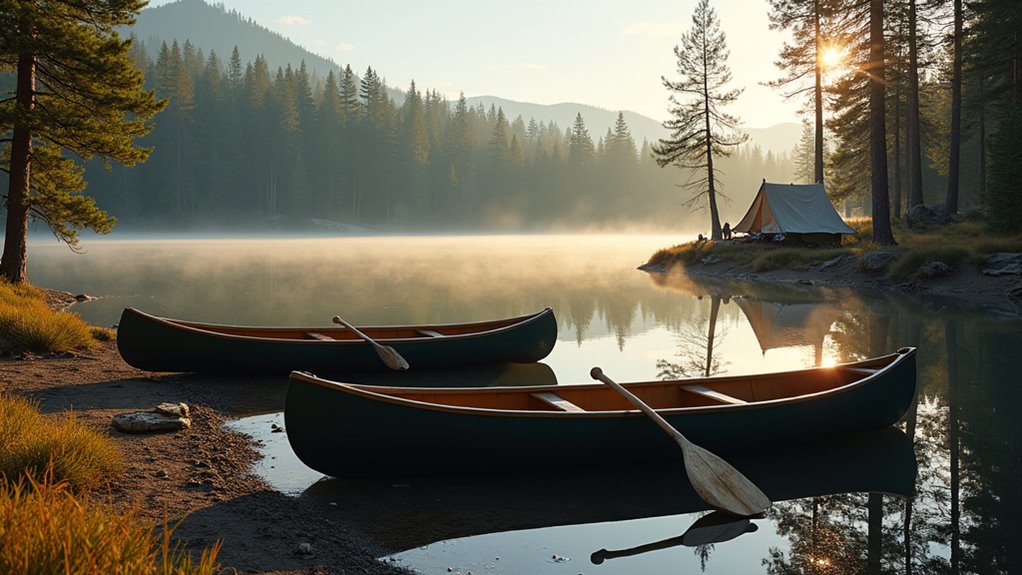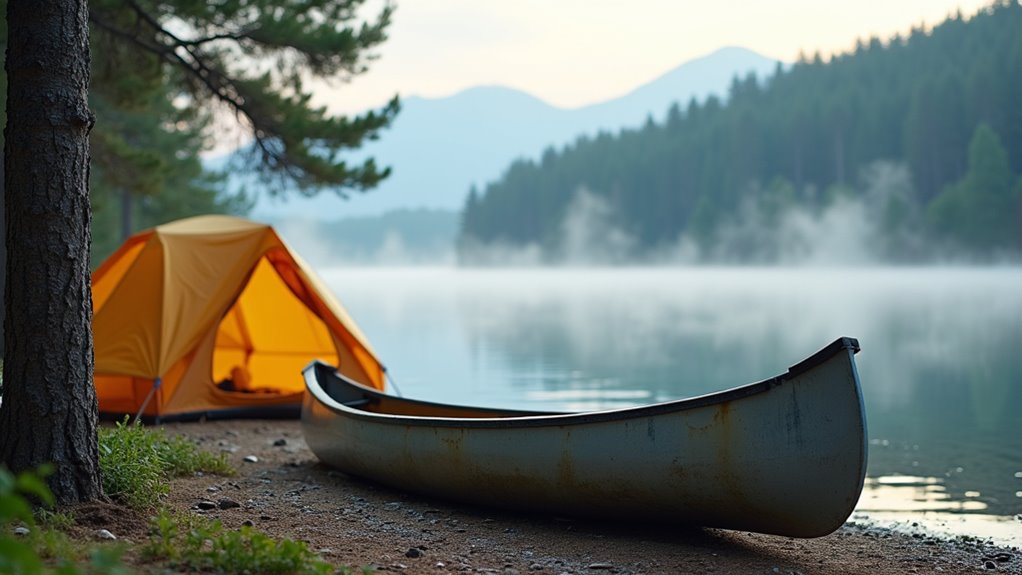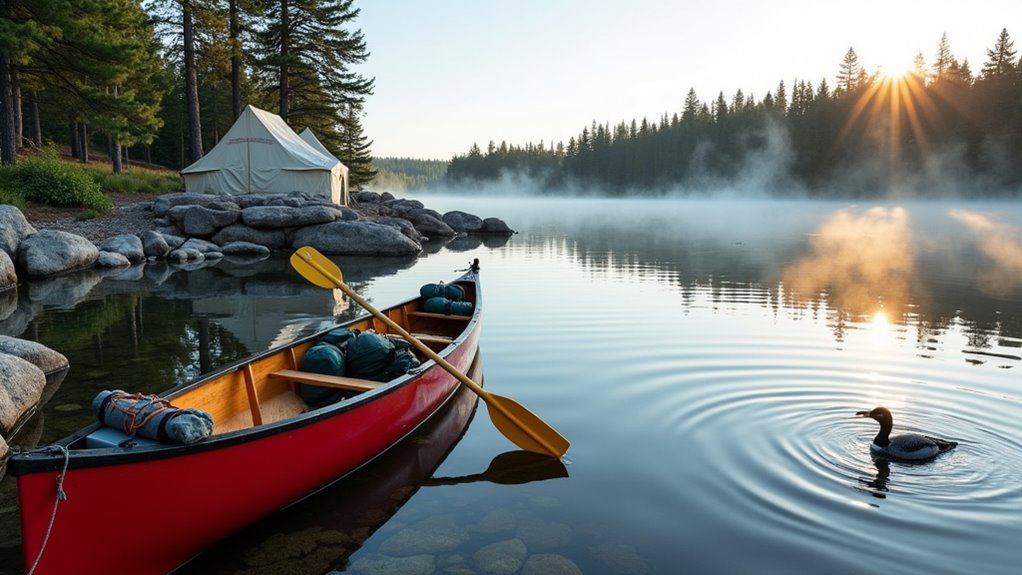Physical Address
304 North Cardinal St.
Dorchester Center, MA 02124
Physical Address
304 North Cardinal St.
Dorchester Center, MA 02124

Inexpensive canoeing gear and safety tips can transform your camping experience, but there's one crucial mistake most beginners make.
Did you know that over 40% of campers who try canoeing for the first time end up making it a regular part of their outdoor adventures? You don’t need to break the bank or become an expert paddler to add this peaceful activity to your next camping trip. The key is understanding which gear you actually need, where to find budget-friendly options, and how to stay safe on the water. Here’s what you should know before you launch.

When you’re planning your first canoe camping trip, you don’t need to break the bank on fancy gear. Start by renting a stable recreational canoe rather than buying one immediately. Look for models that are 16-17 feet long with good tracking ability and decent storage space.
Essential equipment includes properly fitted life jackets for everyone, waterproof dry bags for your camping gear, and basic paddles plus one spare. Don’t forget a bilge pump or bailer for removing water.
Skip expensive carbon fiber paddles initially—aluminum or fiberglass works fine. Focus your budget on quality dry bags since wet gear ruins trips quickly.
Many outfitters offer package deals combining canoe rentals with basic equipment, which helps you test different gear before making purchases. Before finalizing your equipment list, consider the essential tips that experienced campers recommend for ensuring your adventure goes smoothly.
While you’ve got your canoe and basic equipment sorted, your safety gear deserves the most attention since it’s what’ll keep you alive if things go sideways.
Don’t skimp on these essentials – they’re worth every penny:
Check weather conditions before heading out, tell someone your route, and always paddle with a buddy. If you’re planning an extended camping trip with water activities, consider renting an RV as your base camp to store extra safety gear and provide a comfortable retreat after long days on the water.

With your safety gear locked down, proper route planning becomes your next line of defense against dangerous situations on the water. You’ll want to research water levels, weather forecasts, and current conditions through local ranger stations or online resources—most are free and updated regularly.
Check for potential hazards like low-hanging branches, rapids, or dam releases that could create dangerous currents.
Map out your entry and exit points, noting alternative takeouts in case conditions change. Consider your group’s skill level and don’t overestimate abilities.
Download offline maps to your phone since cell service is often spotty near waterways.
Share your planned route with someone reliable who isn’t joining the trip. This simple step costs nothing but could save your life if something goes wrong.
If you’re planning to combine your canoeing adventure with RV camping, keep an eye on current economic conditions that may create opportunities for better deals on recreational vehicle purchases or rentals.
Even if you’ve paddled a few times before, dedicating practice time to fundamental techniques will prevent fatigue and frustration during your camping trip. You don’t need expensive lessons – find a local pond or calm lake to practice these basics:
Practice these techniques until they feel natural. You’ll paddle longer distances with less effort and enjoy your camping adventure more. If you’re planning a winter canoeing trip, remember that proper water treatment becomes even more critical in cold conditions when contaminated water can pose serious health risks.

Three key factors determine your campsite’s success when canoeing: proximity to water, protection from elements, and level ground for sleeping. You’ll want to pitch your tent within 100 yards of your launch point to minimize gear hauling.
Look for natural windbreaks like tree lines or rock formations that’ll shield you from gusts without blocking morning sun.
Natural windbreaks provide essential shelter from harsh gusts while preserving access to warming morning sunlight at your campsite.
Scout for established campsites first—they’re often free and already cleared.
Avoid low-lying areas where water collects during rain.
Test the ground with your foot; if it’s spongy or soggy, keep looking.
Set up on slightly elevated terrain that slopes gently away from your tent.
Check local regulations about camping distances from water sources. Some areas require you to camp 200 feet back to protect wildlife corridors.
If you’re bringing an RV instead of tent camping, ensure your chosen site can accommodate your vehicle’s size and has proper drainage to prevent flooding during unexpected severe weather.
While calm mornings offer the best paddling conditions, you’ll save money and avoid crowds by checking weather patterns before booking your trip. Plan your canoe adventures during shoulder seasons when campground rates drop and water traffic decreases significantly.
Weather directly impacts your safety and enjoyment on the water. Strong winds create choppy conditions that’ll exhaust beginners quickly, while thunderstorms pose serious risks you can’t ignore.
If you’re seeking more adventurous water activities during your camping trip, consider exploring glacier climbing opportunities in mountainous regions where glacial lakes provide unique paddling experiences.

Since you’ll be carrying everything in your canoe, smart packing becomes critical for multi-day trips. Pack light but essential items in waterproof dry bags – they’re your lifeline if you capsize. Prioritize multi-purpose gear like a camp knife that opens cans and cuts rope. Choose lightweight, quick-dry clothing over cotton. Pack one extra day’s worth of food in case weather delays your return.
Essential items include: water purification tablets or portable filter, compact sleeping bag, lightweight tent, camp stove with fuel, first aid kit, headlamp with extra batteries, and duct tape for emergency repairs. Keep frequently needed items like snacks and sunscreen in easily accessible day bags.
Distribute weight evenly in your canoe, placing heavier items low and centered for better stability and handling. Understanding canoeing basics before your first multi-day trip will help ensure you pack appropriately and have the skills needed for a safe wilderness adventure.
When you’re paddling through pristine waterways, you become a temporary guardian of these fragile ecosystems. Following Leave No Trace principles doesn’t cost extra money—it’s about changing habits to protect the waters you love exploring.
Protecting waterways costs nothing but mindful habits—small changes preserve the pristine environments that make every paddling adventure unforgettable.
Smart waterway conservation starts with simple actions that preserve natural beauty for future paddlers:
These practices ensure waterways stay clean and accessible. You’ll save money on potential fines while protecting the environments that make canoeing adventures possible. After a day of paddling, you can fuel up with deli meat sandwiches back at camp without leaving any packaging or food waste behind.
You’ve got all the puzzle pieces—now it’s time to put them together and hit the water! Don’t let your dream canoe camping trip stay anchored to your wishlist. With smart planning, basic gear, and respect for nature, you’ll create memories that’ll ripple through your life for years. Your wallet won’t take a beating either, since canoeing’s one of the most affordable ways to explore the great outdoors. Time to paddle forward!